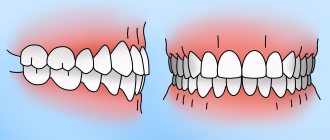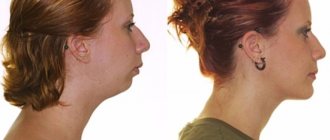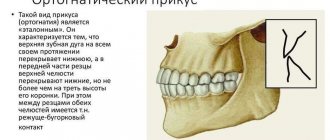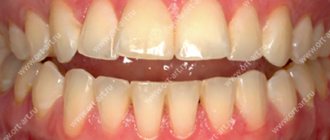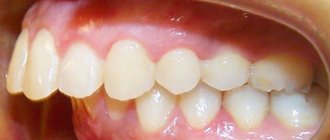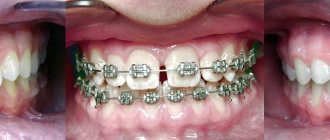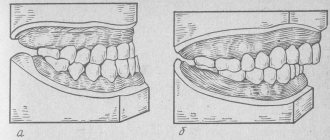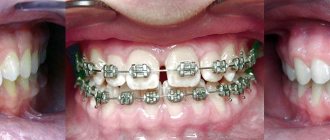Malocclusions negatively affect the beauty of a smile and lead to certain troubles in the future. This article will draw attention to the reasons for the formation of malocclusion in childhood and methods for solving this problem.
Timely contact with an orthodontist protects against dental problems and cosmetic defects in the future. Nowadays, malocclusion occurs in many children. Unfortunately, not all parents pay attention to such issues. By diagnosing problems in the early stages of development and replacement of baby teeth, it is much easier to correct defects, compared to solving the problem at an older age.
Parents are advised to take their child to the dentist for preventive purposes. The period from 3 to 6 years is especially important, because it is during this time that children develop a temporary bite.
Reasons and results
Jaw alignment ensures breastfeeding up to 12 months of age. During lactation, children actively use their facial muscles. It is impossible to achieve a similar result with a bottle, especially when using a nipple with a large diameter hole. Ultimately, the lower jaw experiences minimal load, and its size remains almost unchanged.
Often, malocclusions develop in infancy. This is due to the fact that in newborns the upper jaw is always larger than the lower jaw.
After switching to another food, the chewing apparatus does not work actively enough, which reduces the rate of development of the bones of the upper and lower jaw. This leads to crooked primary teeth.
The lower jaw can also narrow or shift due to the fact that the child sleeps in a certain position - on his side, back, stomach, with his head lowered on his chest or his hand under his cheek. Also, malocclusion is caused by the habit of thumb sucking, lip biting, or sucking on a pacifier for too long.
How to warn?
If a child has a malocclusion at the genetic level, then, unfortunately, this fact cannot be prevented. But other factors can be significantly minimized. To do this, read the following tips:
- The rudiments of teeth are formed in the fetus at 20 weeks. Therefore, the expectant mother is obliged to eat foods with fluoride and calcium.
- Artificial feeding has a bad effect on the bite. The upper jaw of newborns is larger than the opposite one. Their sizes eventually come to the same value due to breastfeeding. At this time, the facial muscles are actively trained. When your baby feeds from a bottle, the hole in the nipple is larger than the “hole” in the breast. It turns out that the child does not suck, but drinks milk in sips.
- Always pay attention to your child's breathing. It should be through the nose. Be sure to consult a specialist if you notice any irregularities.
- When your baby's first teeth begin to appear, wean him off the pacifier or your finger (if he takes it). The risk of malocclusion increases.
- Visit the dentist even for no apparent reason (2 times a year).
In conclusion, we remind you that for a small child the time needed to correct the bite will be less than for older children.
Sources used:
- https://www.dentsplysirona.com
- Feres MF, Abreu LG, Insabralde NM, Almeida MR, Flores-Mir C (June 2016). “Effectiveness of the open bite treatment in growing children and adolescents. A systematic review". European Journal of Orthodontics.
- Fishchev, S.B. Emergencies in dentistry and maxillofacial surgery.
Danger
- Excessive stress during chewing food leads to the fact that at the age of 30-40 years the necks of the dental elements become exposed, mobility of the teeth and spaces between them appear, and the gums begin to bleed.
- Bite defects provoke aesthetic problems (ugly smile, deterioration of facial profile and crooked teeth).
- Malocclusion leads to problems with the temporomandibular joints, which results in headaches, pain when chewing, and clicking when opening the mouth.
Bad teeth cause adolescence complexes
Teenagers are vulnerable and impressionable. Their unstable psyche often becomes the cause of megalomania and an inferiority complex “in one person.” To help a child overcome his complexes (“I’m an ugly duckling”, “I’m not like everyone else”) and learn to feel comfortable in society, you need to help him love himself. And an important step towards solving problems can be working on a beautiful smile: straightening your teeth and correcting your bite.
By the way, it has been proven that braces not only help the child himself overcome the difficulties of adolescence, but also have a beneficial effect on the attitude of his peers towards him. Taking care of your appearance is increasingly becoming fashionable. Therefore, a teenager with braces and straight teeth will feel much more confident in the company of friends. And the orthodontic structures themselves can become a very fashionable and elegant decoration - you can choose aesthetic braces.
Open bite
This malocclusion is manifested by the lack of vertical connection of the teeth in a horizontal plane. In most cases, the problem occurs with the front teeth and only sometimes in the area of the lateral teeth. The problem can appear at any age. The main causes: rickets, as well as injuries caused by prolonged sucking of lips, tongue, fingers, cheeks and various objects.
At the first stage of treatment, it is necessary to identify and eliminate the factors that led to the problem. Doctors recommend a special diet, myogymnastics, and the use of a chin sling. In addition, measures are taken to normalize speech, swallowing, restore the functions of the tongue and nasal breathing.
Treatment is carried out using plates with screws and springs, as well as vestibular arches. The main purpose of the structures is to correct the tone of the masticatory muscles, change bone tissue and restore the functionality of the tongue. In most cases, several methods are used simultaneously.
Orthodontic method
Incorrect child bites can be corrected using screws, trays and veneers.
Mouthguards align the entire row of teeth. They are made individually. Once every 2 months the structures are replaced with new ones. Mouthguards cannot correct complex cases (mesial, deep, distal bite).
Veneers restore the front teeth well, thereby helping to visually hide an incorrect bite. Composite veneers are not durable, ceramic ones are expensive. The use of veneers requires grinding down the tooth enamel.
Orthodontic screws and appliances are used for crossbites. The devices operate on the principle of mechanics.
Mesial bite
The anomaly consists in the lower jaw being significantly pushed forward in relation to the upper jaw. This deformity is manifested by an underdeveloped upper jaw or an overdeveloped lower jaw. There is also a combination of two problems.
Visual signs of violation:
- concave face shape;
- pain in the facial joints, as well as crunching and clicking when chewing food and when opening the mouth;
- protruding chin;
- position of the lower jaw incisors in front of the upper ones with the jaws closed.
Crossbite
A malocclusion in which one jaw is narrowed, and the lower jaw also shifts to the right or left, which disrupts the symmetry of the face. The anomaly can be one- or two-sided and can develop in the frontal and lateral areas of the jaw.
Factors provoking the appearance of a defect:
- improper eruption;
- too late change of primary teeth;
- hereditary causes;
- too early loss of primary teeth;
- chronic otitis;
- disruptions in the development of dental arches and jaws in childhood.
Application of records
The design does not require constant wear and is a removable device. It is usually removed during meals or under other circumstances when the baby feels discomfort from it.
The design has several metal elements (screws, hooks, arcs and springs). It is made separately for each patient. The manufacturing procedure is as follows: an orthodontist examines, takes impressions of the jaw, a plaster model is cast in the laboratory based on the impressions, and a plate is made based on the resulting model. The orthodontist independently adjusts the position of the springs and hooks. Such actions by the doctor allow you to move the teeth and dentition in the right direction.
Plates effectively correct malocclusion in the early stages. But sometimes you can hear from friends that the above-described structures did not allow their children to correct their bite. It is not true. With constant wear and compliance with all the recommendations of the orthodontist, the desired result will definitely occur. Although the plates are not permanently installed devices, they must be worn without removing them. It is allowed to remove the structures only when eating, brushing your teeth and in some other life situations (for example, when taking photographs).
Some capricious children do not want to wear records. The task of parents is to convey to the child information about the need for treatment. At the same time, there is an urgent need for constant monitoring of the child. You will need to monitor whether the child has removed the device.
Deep bite
In the presence of this disorder, the upper incisors overlap the lower ones when the jaws are closed by more than 1/3. This not only creates inconvenience due to visual defects, but is also accompanied by other problems.
What does a deep bite lead to:
- speech disorders;
- aesthetic problems (too short lower part of the face and unnatural position of the lips);
- increased load on the front teeth;
- damage to the oral cavity;
- difficulties while eating.
In many cases, deep bites are accompanied by problems such as headaches, crunching, clicking and discomfort in the temporomandibular joint.
Diastema
A violation of the arrangement of teeth, in which there is a gap of 1-6 mm between the central incisors. In most cases, the problem occurs in the upper jaw. The appearance of a diastema negatively affects the quality of speech and appearance of the patient.
Reasons for the development of the defect:
- dense bone septum between the central incisors;
- too late change of elements of the dentition;
- low location of the frenulum of the upper lip;
- premature loss of anterior tooth;
- disturbances in the development of lateral incisors;
- incorrect position of the anterior dental elements.
Correction of bite defects
Correcting malocclusion development is a slow and complex process that consists of the following main stages:
- Diagnostics with determination of the level of complexity of future treatment by an orthodontist. The specialist takes a photo, performs oral cavity sanitation, teeth remineralization and stone removal.
- Use of removable and non-removable structures. Braces are installed on the inner or outer surface of the teeth using special glue. Power arcs made of material that can remember a given shape are attached to the grooves. Thanks to this, the doctor corrects the bite.
The process of correcting malocclusions using braces lasts from 6 to 24 months or even more. The timing depends on the characteristics of the periodontium, the level of complexity of the problem and the age category of the patient. Treatment involves regular visits to a specialist to monitor the process.
In some cases, the final stage of correcting malocclusion in children is the installation of bridges.
You need to understand that it is very important to brush your teeth regularly and diligently after any meal. Visits to the hygienist for preventive purposes are also a mandatory factor.
After treatment of an open bite is completed, it is recommended to use removable tongue rests to protect the correct bite from tongue influence.
Braces
Installing braces is the most common and affordable way to straighten your bite. Under the age of 10, the problem can be solved with the help of trainers or plates. With minimal disruption, they demonstrate excellent results. At older ages, children's braces are already used. During the teenage years, using braces allows you to achieve optimal results without pain, which is not the case with braces designed for adults.
Before installing a bracket system, you need to select the best option together with a specialist. Various braces options have been developed for children:
- metal;
- plastic or ceramic;
- lingual.
The choice must be taken seriously, since even a specialist cannot determine in advance exactly how long the structure will remain in the child’s mouth.
Care
Parents should show their child how to properly care for installed devices. Poor hygiene will greatly increase the risk of dental caries. Maintenance consists of regular cleaning. It is advisable to have a separate brush for plates and trays. In addition to it, you can use pastes and gels sold through the pharmacy chain.
Special attention must be paid to braces systems. Due to the fact that it is not removable, a large amount of food gets stuck in the structure. Therefore, it needs to be cleaned after each use. Threads and brushes will be used to help the patient.
Parents either must teach the baby to perform care procedures correctly or take on the entire process themselves. Here control from the older generation is necessary.
At what age can children get braces?
Braces are fixed on a pair of chewing teeth located at a great distance from the canines and incisors. In this regard, their installation is possible after all the elements of the dentition have appeared, which usually occurs by about 12 years. In some cases, braces are installed on temporary teeth under the age of 10 years. This is not accompanied by pain, although certain difficulties are still possible at first. After the formation of the bite is completed (after 14 years), it is recommended to begin treatment as quickly as possible. Of course, it is possible to correct bite defects using modern methods at any age, but at an older age it takes much more time.
What are Invisalign aligners for children?
Aligners (aligners) are orthodontic products designed for the comprehensive correction of bite defects. They look like transparent covers on the teeth. They differ from sports mouthguards in the precise positioning of each dental element. They are made according to individual patient parameters from durable hypoallergenic thermoplastic medical material.
There are many companies producing aligners. But the most effective and aesthetically pleasing are the products of the American company Align Technology, founded in 1997. Aligners are produced under the Invisalign brand.
Until recently, only adult patients could use these products. Today the company launched a new aligner model, Invisalign Teen, specifically designed for teenagers. These aligners have all the benefits of adult aligners plus their own advantages:
- color indicator of wear level. When it's time to swap out the item you're wearing for a new one, the bright blue color of the marker fades;
- growth compensators for teeth;
- attachments that allow you to tightly fix the trays on the dentition;
- edges that copy the shape of the gum.
Invisalign aligners for teenagers can be used not only for a separate therapeutic course, but also as retainers after completed correction with braces.


